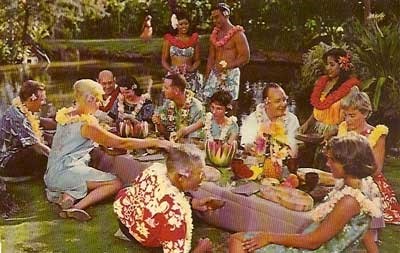Hawaiian Luas: A Sacred Feast or a Party in Paradise?
Students in Dr. Karen Metheny’s Summer Term course, Anthropology of Food (MET ML 641) are contributing guest posts this month. Today’s post is from Ashley Lopes.
When I think of Hawaiian luaus, I think of men, women, and children dancing, singing, and eating together at one glorious table. I imagine a lavish, tropical feast, accompanied by games, music, and hula. In our Anthropology of Food class, we learn how food can symbolize identity, social values, and cultural transformation. Hawaiian luaus for example, reflect Hawaii’s shift in foodways.
 Today’s movies, tv shows, and books all portray the luau as a party in paradise. In the article “Luaus, Authenticity and the Anthropology of Food,” however, Kaori O’Connor (2008) reveals that the modern-day conception of Hawaiian luaus is highly romanticized and idealized. Before contact with Western cultures, eating and feasting in Hawaii were linked to religion and sacrality – to feeding the gods and offering sacrificial foods. Men and women of all social classes were regulated by food taboos and restricted from eating the same foods at the same tables. Men oversaw the gathering, fishing, provisioning, and production of food. Women, on the other hand, were not allowed to take part in any of these activities. They had very little freedom in what they could do. During the traditional luau, food was served cold, people sat on the floor, and everything was eaten with hands.
Today’s movies, tv shows, and books all portray the luau as a party in paradise. In the article “Luaus, Authenticity and the Anthropology of Food,” however, Kaori O’Connor (2008) reveals that the modern-day conception of Hawaiian luaus is highly romanticized and idealized. Before contact with Western cultures, eating and feasting in Hawaii were linked to religion and sacrality – to feeding the gods and offering sacrificial foods. Men and women of all social classes were regulated by food taboos and restricted from eating the same foods at the same tables. Men oversaw the gathering, fishing, provisioning, and production of food. Women, on the other hand, were not allowed to take part in any of these activities. They had very little freedom in what they could do. During the traditional luau, food was served cold, people sat on the floor, and everything was eaten with hands.
So where does the modern luau come in? Why have Hawaiian food taboos been forgotten? When American missionaries arrived in Hawaii, they took it upon themselves to “civilize” and change the foundational principles of Hawaiian society. Missionary wives taught Hawaiian women how to cook refined, Western-style food. Tourist promoters used postcards to publicize Hawaiian luaus as lavish (but civilized) feasts that catered to Euro-Americans and Asian immigrant groups. The luau menu began to offer multi-cultural dishes – a fusion of macaroni and potato salad, fried rice, sushi, and barbeque steak. O’Connor argues that luaus continue to be an obligatory part of the Hawaiian tourist experience because they transport the eater to an exotic, purist realm. She makes an interesting point that authenticity is relative and ever-changing. Over the course of Hawaii’s history, the traditional luau has been molded and reinvented into a mashup of different cultures, food practices, and flavors.
Works Cited
O’Connor, Kaori. 2008. “The Hawaiian Luau: Food as Tradition, Transgression, Transformation and Travel. Food, Culture, and Society 11(2): 149-172.